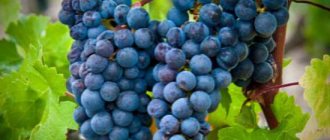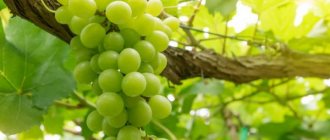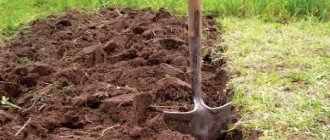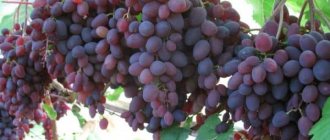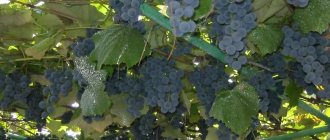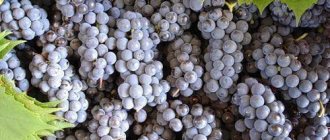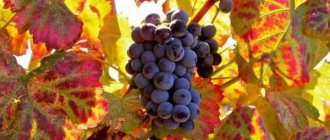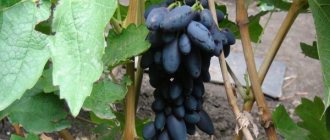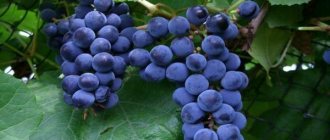Sauvignon Blanc is an industrial grape variety used to make white wine. The Loire Valley in France, which holds the record for the cultivation of this variety, is considered to be the birthplace of this berry. The word Sauvignon comes from the English sauvage, which means wild grape.
Wine experts believe that the technical grape variety is the result of crossing Traminer and Chenin Blanc. In France it is considered an elite grape variety. Its berries produce fresh and light wine. Sauvignon Blanc is added for blending, for example to make sweet Sauternes wine. It ranks second in popularity after Chardonnay and is cultivated in many countries around the world: Australia, Germany, Italy, Argentina, Chile, Canada and others. Sauvignon is also popular in the USA, although it has a different name, Fume Blanc.
Description and features
Description of the variety includes the vine, inflorescences, berries, taste, region of growth. You can grow such grapes in your own garden. However, for this it is necessary to create optimal conditions. Sauvignon is a technical variety.
Vine
Grape bushes form vines. These are the characteristics of the growth of this culture. They are long branches that are attached to a trellis. Foliage grows from them and grapes hang down.
At the beginning of the growing season, the grape vines have a reddish-green hue. Later they turn green, then become covered with bark. Lignified vines bear fruit for several years in a row. The foliage is green, the blades are large, and have dissections into 3-5 parts.
Inflorescences
The inflorescences are densely collected in clusters. The flowers are white, the petals are sharp. After flowering ends, berries form. Almost in place of each flower, fruits are formed. Flowering is long, the variety belongs to mid-season grapes. Harvesting begins in September or October.
Berries
The fruits are collected in cylindrical or conical clusters weighing up to 150 g. Each berry weighs 3 g, they fit tightly to each other. The color is light yellow or green. The shape of the grapes is elongated, oval. The harvest does not fall off, ripening lasts about 1.5 months.
Taste
Sauvignon is one of the most popular varieties. Its taste is high. Grapes contain a sufficient amount of sugar and vitamin C. The berries have a pleasant sweet taste.
Growing region
After the grape variety was developed, it was distributed throughout the world. However, it is not possible to create optimal growing conditions in all countries due to different climatic zones. Most of it is grown in the following areas:
- Bulgaria;
- Montenegro;
- USA;
- Africa;
- France;
- Italy;
- SOUTH AFRICA.
Important! Recently, attempts have been made to grow Sauvignon in Russia.
Harvesting, storage and processing
Sauvignon has poor keeping quality, the berries are perishable, after a week they begin to rot. If you wish, you can quickly prepare juice at home and process grapes into wine. The taste and properties of the berries of this variety do not allow the use of wooden containers in wine preparation technology - glass bottles are used, the strength of the wine reaches 13. The taste of wine does not improve during storage; it is consumed in the first years of production. Wine can be stored in glass bottles for no more than 3 years.
Main characteristics
To start growing grapes on your own plot, you need to study its characteristics in detail. For different regions, it is important to have certain adaptations to the environment.
Drought resistance
The grapes have average resistance to heat. The culture prefers an average warm climate. The roots of the plant are not well developed enough to draw water from ground deposits. If you plant Sauvignon in the south, it will require regular and additional watering.
Frost resistance
The plant can survive temperatures not lower than -25 °C. The root system is mulched for the winter, and the vine and shoots are covered with breathable insulation materials. If this is not done, the bush will freeze and will have to be re-formed. In the worst case scenario, the vineyard roots will die and the plants will need to be replanted.
Areas of application of berries
Sauvignon grapes are processed into wine, grape juice and other juice-containing products. This variety is technical. After harvesting, the berries are not stored, but are directly sent for processing.
Some varieties of elite wines are prepared from these grapes:
- Chateau Los Boldos;
- Sauters;
- Madfish;
- Laith Harvest.
See also
Characteristics and description of Daria grape variety, planting and care
Read
Wine usually has 13% or more alcohol. The drink has a slight gooseberry scent and tart taste. As a result, dry, semi-dry, semi-sweet and sweet wines are prepared.
Sauvignon does not keep fresh for long, even in bunches. When growing it in your own garden, you need to ensure its prompt processing.
Resistance to diseases and pests
The vineyard has strong immunity to almost all diseases characteristic of the crop. Its only enemy is gray rot. There are also cases of leaf roller infestation. When taking preventive measures, Sauvignon does not get sick.
Advantages and variety of types
This variety without blending is used for the production of elite, expensive varieties of dry and semi-sweet wines, champagne, and grape juices; like any grape, it is delicious fresh. The exquisite taste of the variety varies depending on the ripeness of the berries, weather conditions during the ripening period, and soil composition.
Sauvignon Blanc is used to enrich the taste of white varieties of other wines.
Blanc means white in French. The berries of Sauvignon Blanc are light straw in color, the wines from this variety are light with a golden tint, it has related varieties obtained through natural changes: Sauvignon Gris (or Rose), Sauvignon Noir, Sauvignon Violet, which have similar properties and taste.
Varieties
Sauvignon has its own varieties of grapes. It comes in black, pink, white and nutmeg.
Black
The mid-ripening variety produces large bunches of grapes, up to 400 g. The berries are small, slightly elongated. The bush is medium-sized, takes root well in the south, the yield is up to 60-70 liters of berries per plant. The color of the fruit is dark purple, almost black. It is used to make red wines.
Pink
Sauvignon Gris has pink berries. Ripening time is average, harvesting occurs in late September or early October. The bush is medium-sized and grows well on a trellis. Rose wines are made from these grapes. They have a slight pink tint.
White
Fruit ripening occurs in mid-autumn. Suitable for growing in southern regions. Forms small clusters weighing up to 180 g of a cylindrical or conical shape. Resistance to frost and drought is average. The immune system is strong and she rarely gets sick.
Muscat
A special hybrid variety. The color of its berries is distinguished by a light pink blush. The bush smells like nutmeg. Its ripening period is average, the berries are small, up to 3 g each. Collected in dense clusters of 200 g. Muscat wines are made from grapes.
The bulk of wines are made from white and black grapes.
Leading characteristics of the variety
The leading characteristics of the White Sauvignon grape variety are: funnel-shaped and grooved leaves with strongly wavy (frill-like) edges and thick cobwebby-bristly pubescence. Very dense, cylindrical clusters (like a corncob) with a slanted base. Small greenish-yellow berries with a nightshade flavor. The seedlings are spreading and densely leafy. Their tops are heavily pubescent, with pink spots, the leaves are wavy, with a blunt central lobe and transitional to dome-shaped denticles. Autumn leaf color is yellow.
Pros and cons of the variety
Each grape variety has its own advantages and disadvantages. It is recommended to study them before planting in your own garden. The positive aspects include:
- unpretentious care;
- high productivity;
- disease resistance;
- adaptability to new conditions;
- average crumbling;
- special taste.
Among the disadvantages, gardeners note:
- bright, tart taste;
- tendency to peas;
- tendency to shedding;
- short-term storage.
Advantages and disadvantages
- The presented variety is of interest to farmers due to its advantages, among which are the following:
- high fertility (up to 60–90 centners per hectare);
- harmonious taste indicators;
- suitability for the production of branded alcoholic beverages and quality nectars;
- good winter hardiness;
- the ability to withstand prolonged rains (the bunches are able to stay on the branches for a long time without signs of rotting);
- increased resistance to diseases and parasites that often attack the grapevine.
Among the disadvantages of the hybrid, winegrowers note possible peas, as well as partial or massive shedding of the ovaries. But with proper care, you can forget about these disadvantages.
How to plant correctly
Proper planting of a bush is the key to a good harvest and a healthy vineyard. To ensure that everything happens according to the rules, it is recommended to study issues related to the selection of seedlings, planting location and planting technology.
Recommendations for choosing deadlines
For planting grapes, choose autumn or spring. In early spring, planting is successful; the vine has time to take root well by winter. However, this does not provide a complete guarantee of survival in winter. It will be difficult for a young seedling to survive frosts.
Therefore, it is recommended to carry out planting work in the fall. Preferably mid-October. During this time, the bush will take root sufficiently and adapt to winter frosts.
Selecting a location
The most optimal place for a vineyard is the south side with constant lighting. Choose an elevated area to protect the roots from flooding during rains.
Soil requirements
It is desirable that the soil be loamy or sandy loam. If it has a sandy or clayey structure, then sand is added to it and a hill is formed. Drainage is laid at the bottom of the planting hole to create additional outflow of liquid.
Site preparation
The planting area can be prepared in advance. To do this, dig it up, remove weed roots and stones, and, if necessary, mix it with sand. Regulate soil acidity. Grapes require neutral or slightly acidic acidity. In other conditions, it is unlikely to be able to bear fruit normally.
How to select and prepare planting material
It is worth buying grape seedlings in trusted specialized stores and nurseries. You should pay attention to the condition:
- root system;
- foliage;
- shoots and vines;
- scion sites.
All areas of the seedling must be moist, without stains, cracks, chips, cuts, or scratches. Roots and leaves should look healthy, without plaque or suspicious signs.
Planting scheme
Seedlings are planted at a distance of 1.5 m from each other. Since subsequently the culture grows greatly in different directions. This will help avoid tangling the vine. Landing is carried out according to a certain algorithm:
- Dig a hole 70 cm deep and 50 cm in diameter.
- Lay 40 cm of peat on the bottom to create drainage.
- A seedling is placed in it.
- Sprinkle with earth and compact.
- Then add 300 g of potassium fertilizers and superphosphate.
- Cover with earth and compact.
- Pegs are driven in at two edges of the planting and the plant is tied.
- Water the bush.
- Mulch with sawdust, straw, cut grass, and moss.
See also
Description and characteristics of the 45 best frost-resistant grape varieties
Read
Important! It is recommended to install trellises on the vineyard site in advance so as not to injure the bush during transplantation and installation of the structure.
A little about taste
The popular grape variety Cabernet Sauvignon was developed in France in the 17th century.
by the method of folk selection. In this state, it is still one of the most widespread of all industrially grown technical varieties. In terms of popularity at the moment, it is second only to Merlot grapes. Currently, this wonderful grape is grown not only in France, but also in many other countries. For example, farmers in the USA, Japan, South America and Mediterranean countries cultivate it. These grapes are grown in Ukraine and Russia.
Cabernet Sauvignon is a grape variety whose berries are not eaten fresh. It's all about their special herbaceous tart taste. The berries have a characteristic nightshade smell. Their taste is slightly reminiscent of currants. The wine made from Sauvignon berries has approximately the same qualities. The finished drink is tart with a subtle nightshade scent.
Rules of care
Sauvignon grapes, like other crops, produce high yields if the rules of care are followed. It is necessary to ensure the necessary regime of watering, fertilizing, protection from rodents and birds, pruning, weeding, loosening and spraying.
Watering mode
The plant does not really like frequent watering. The procedure is carried out three times per season:
- immediately after removing the winter shelter;
- during flowering;
- during the fruiting period.
In the interval, irrigation is repeated only in case of prolonged drought and drying out of the soil at the root. When overwatering occurs, there is a possibility of developing gray rot.
Top dressing
If fertilizers were added to the soil during planting, then there is no need to repeat feeding for the next 3-4 years. Next, organic matter or mineral fertilizers are added. Suitable from organic:
- wood ash;
- compost;
- manure;
- humus.
Of the minerals, grapes respond well to:
- ammonium nitrate;
- urea;
- potassium compounds;
- superphosphate.
Excess fertilizer leads to the death of the plant; do not increase the dosage.
Rodent protection
To protect against small rodents, special poisonous agents are used. They, according to the instructions, are laid out on the soil under the bush. They repel pests, and when approached, lead to their death.
Preparing for winter
Preparing a vineyard for wintering includes several stages:
- mulching roots;
- sheltering the vine from frost using spunbond or agrofibre;
- pre-winter watering;
- fertilizing.
How to protect crops from birds
Birds often like to feast on the grape harvest. To protect against their attack, a special net is put on each bunch. It allows air and light to pass through well and does not interfere with the ripening of berries.
Mulching
Mulch helps retain moisture and nutrients at the roots of the grapes. At the same time, it protects the roots in winter. A variety of materials are used for this:
- straw;
- peat;
- chopped grass;
- moss;
- sawdust.
The selected composition is laid out in an even layer around the trunk of the bush.
Trimming
Pruning grapes is a mandatory procedure to preserve high yields and healthy crops. After planting, every spring for 3 years they are engaged in the formation of a bush. In the fall, sanitary pruning is done. Remove dry leaves, weather-damaged areas of the vine, and branches growing in the wrong direction.
In the summer, if necessary, thinning grape pruning is done. They look through the bush and cut off excess shoots in thickened areas.
Preventive spraying
To prevent grapes from getting sick with fungi and being affected by leaf rollers, in the spring, before the juice begins to flow, the plant is sprayed with fungicides and insecticides. This will ensure a healthy harvest.
Weeding and loosening
Be sure to do weeding and loosen the soil around the roots of the grapes. These manipulations help maintain the required amount of nutrients for the plant. This is done as the weeds grow and a surface crust forms.
Features of the Cabernet Sauvignon grape variety
A lot is known about the characteristic positive and negative aspects of the Cabernet Sauvignon grape variety due to its popularity among amateur winemakers and professional winegrowers.
So, the variety is high-yielding, but requires attention, care and stable climatic conditions. If all these conditions are met, up to 70 centners of berries can be collected from 1 hectare of land. The fruits tolerate transportation well over long distances without losing their presentation, thanks to their dense skin. For the same reason, Cabernet Sauvignon grapes do not burst while growing on the vine, from where they practically do not fall off.
Another advantage of the thick skin of the fruit is the ability to not worry about the harvest time, since even when overripe the berries do not crack or burst. The variety is resistant to frost and drought, and is not afraid of most pests and diseases. The Cabernet Sauvignon grape variety is grown for the industrial production of dessert red wines.
Wine from Cabernet Sauvignon grapes: photo
As for the weaknesses, it is worth noting the likelihood of pea crops, and, consequently, the need to control the progress of the pollination process, and sometimes manual pollination, which takes a lot of time. During the ovary period, the plant is afraid of strong winds, since they can cause them to fall off during the initial ovary period. The variety prefers warm and stable climatic conditions and does not like rain, so this grape variety is not suitable for any region of both Russia and the world. More of a feature than a minus is the fact that Cabernet Sauvignon grapes are late-ripening varieties; the berries appear 145-155 days after the formation of the ovaries.
Cabernet Sauvignon grapes: photo of the variety
Diseases and pests
Sauvignon almost never gets sick. Among the diseases that affect grapes is gray rot. This fungus develops in high humidity. A gray fluffy coating appears on the berries, vines and leaves. The disease can be controlled with a fungicide.
Leaf rollers are the main enemies of grapes. Their larvae are stored at the roots of the plant. Then the beetles hatch and feed on the leaves and fruits. They can be destroyed with insecticides, as well as by destroying nests.
How Sauvignon Blanc became a superstar
Sauvignon Blanc grapes were first planted in New Zealand in the early 1970s. But after just a few decades, it became the most cultivated species in the country, and local wines produced from it began to be considered among experts as perhaps the best in the whole world. The reason for this is the same climate and soil characteristics. Thanks to them, drinks with a soft taste are obtained, where shades of ripe juicy peaches, melons, and exotic fruits are harmoniously combined - this is true for wines from the north of the country. Wines from the south of New Zealand are characterized by powerful, fresh mineral notes, flavored with accords of gooseberry and sweet pepper.
In New Zealand, the climate contributes to the fullest development of the taste of Sauvignon Blanc berries
Have you found your Sauvignon Blanc yet? If not, then be sure to come to our wine supermarkets and don’t delay getting acquainted. If yes, then we are even more waiting for you - because we will certainly have something that will pleasantly surprise you.
Always yours, Fragrant World
Production of Sauvignon Blanc
The production of wine blanca is a complex process that has a large number of subtleties, but at the same time it is quite free, unlike other types of this alcoholic drink. There are no clear rules here, so each manufacturer sets their own.
Interesting
As mentioned above, grapes of this variety are most often harvested unevenly - thus, each berry has a different degree of ripening, and therefore taste and richness.
The winemaker has the right to independently decide when exactly the grapes should be harvested. There are no exact recommendations on this matter. The same applies to the filtration of grape must, that is, the time when it is necessary to separate the must from the skins, whether the wine should be bottled, and whether it should be left to “ripen” and in what vessel. For ripening, some manufacturers use wooden barrels, others use special stainless steel containers.
The fermentation temperature of wine differs in different regions. Usually in Europe it is lower than in the homeland of the Savignon variety - in France.
Caring for young and mature vines
Cabernet grapes are unpretentious to the soil when planting, but wetlands require good drainage. The seedling takes root well in a new place, regardless of the time of planting.
It does not require further scrupulous attention: it is an excellent option for beginning gardeners to try their hand at it.
Top dressing
In the first years after planting, the grapes are not fed with anything. The necessary microelements added to the soil during the preparation of the planting hole are sufficient for him.
You can saturate the grapes with organic matter by covering the root zone with mulch from rotted manure or diluting it in water and combining it with autumn watering.
Grapes need periodic watering, but excess moisture negatively affects its development.
Overwatering during the ripening period causes watery berries, so you should not overwater the plants. High humidity often causes the development of fungal diseases.
During the season, grapes are watered at least three times, depending on weather conditions. In the case of a winter with little snow and dry soil after the spring melting of snow, the grapes need abundant watering. Watering must be repeated before flowering and in the fall.
Trimming
For Cabernet grapes, formative pruning is practiced. In this case, no more than six side shoots are left, the rest is removed. This pruning promotes the active development of lower buds and increases yield. A bush that is too busy bears little fruit.
Proper planting of grapes does not guarantee a rich harvest. When growing, care is also important.
Top dressing
During the growing season, the plant needs feeding, for which mineral and organic fertilizers are usually used. It must be done no later than the 2nd week of July.
Subsequent feeding of the bush can provoke increased vegetation. A large number of leaves can block the grape bunches from the sun, resulting in slower ripening.
Spraying grapes using powder fertilizers
Berries need watering during the ripening period. Do not flood the bushes. This will negatively affect the quality of the berries - they will become watery. In addition, high humidity is a favorable condition for the development of fungus.
Trimming
To form a vineyard, you should trim the branches to approximately 5-6 buds. Because of this, the lower buds will begin to develop and, as a result, fruitfulness will increase.
Harvest time depends on the purpose of cultivation. You can collect fruits using a combine.
Autumn pruning of cabernet sauvignon varieties before winter
To obtain a stable harvest, it is necessary to properly care for the grapes. Care includes: fertilization, watering, weeding, bush formation, vine pruning, prevention from pests and diseases.
Fertilizer
Manure contains nitrogen, potassium, phosphorus and trace elements. Every 3 years it is applied at the rate of 6-8 kilograms per 1 square meter (in the fall before digging). Phosphorus and potassium fertilizers are used along with manure at the rate of 50-60 grams per 1 square meter. Potassium humate is a universal fertilizer that stimulates plant growth and development; fertilizing is carried out according to the instructions. Nitrogen fertilizers are used annually in the spring at a rate of 3-4 grams per 1 square meter.
This variety does not like excess moisture; watering is carried out as the soil dries out. At a depth of 20 centimeters, take a handful of earth and squeeze it in your fist; if the earth crumbles without forming a lump, then watering is required. Excess water leads to rotting of the root system or the development of gray rot.
In the first year (dry summer), the grape bush is watered up to 4 times, 4 buckets of water per bush. After watering, the bush is mulched with humus 10 centimeters thick.
Formation
The formation of the bush begins in the first year of planting and is carried out annually. Fan and multi-arm fan formations of grape bushes involve from 4 to 8 fruit arms extending from the base of the bush. Each has a fruit link - this is a fruit vine and a replacement knot.
Sauvignon Blanc is resistant to infection by mildew and oidium spores. During rainy seasons, it can become infected with gray mold spores. When the berries are infected, noble mold is formed, which gives the wine an exquisite taste; when the leaves become infected, work is carried out to collect and destroy them.
Among the pests, grape leaves are affected by mites, and the berries are eaten by wasps. For preventive purposes, it is enough to treat grapes with combined fungicides in the spring and after flowering. Special traps are installed for wasps.
Before planting, you should take into account the fact that Cabernet Sauvignon is highly sensitive to soil. The landing site should be chosen especially carefully. Also, when planting, you must consider the following:
- planting dates do not differ from any other hybrids and grape varieties, which implies planting in early spring or mid-autumn;
- it is preferable to plant grape seedlings on southern slopes or at sufficient elevations;
- when planting seedlings, the width between rows should be 3-4 meters;
- when growing berries for the purpose of preparing vintage wine, the length of the fruit shoots and the load on the bushes should be reduced;
- It is important to shorten the annual type of shoots by 5 or 6 eyes.
It should be noted that even when the bushes are overloaded, the berries are capable of very high sugar accumulation.
Rules for serving Sauvignon Blanc
In order to fully experience and taste the taste of Sauvignon wine, you should also know the rules for serving it.
The first rule concerns what exactly this drink should be served in. According to tradition, this wine is tasted from full-bodied wine glasses on a thin stem, which must be transparent.
This way, not only the golden color of the drink will be noticeable, but also its fresh and pleasant aroma will be perfectly felt.
Also pay special attention to the temperature of the wine. It should not be warm; before serving, the drink must be cooled to about 12 degrees. Most alcoholic drinks are served at this temperature. This is due to the fact that in this way it is possible to achieve the ideal combination of taste and manifestation of all the qualities of each specific product.
But in addition to how to serve Sauvignon correctly, it is also important to understand what products it can be combined with. This applies to any wine, since this drink is very specific and in some cases may not emphasize, but drown out or spoil the taste of food.
Food combinations of Sauvignon Blanc
White Sauvignon is a unique wine in terms of combination with various products. It goes great with any seafood, fish and white meat. One of the peculiarities is that it is combined even with sushi - this dish is strictly contraindicated to be consumed together with any other wine, since the taste of both products deteriorates significantly.
This does not happen with white Sauvignon. It complements any of these dishes without interrupting or drowning out their taste.
Another possible combination would be serving wine with cheese. Salads served to the table should be just as light - without fatty and thick sauce; steamed dishes are also perfect.
Serve a variety of appetizers along with the Sauvignon. They are suitable for those occasions when wine is served as an aperitif. But remember that you should not serve too complex dishes - sandwiches or tartlets with a lot of mayonnaise and other culinary delights.
This drink, contrary to the established opinion that the older the wine, the better it is, is not recommended to be stored for a long time. In this case, notes of peas appear in it. But some producers can make such a wine tasty and attractive, highlighting all its shortcomings favorably.
Wine regions
Differences in taste may not only be due to the fact that producers in different parts of the world use different technologies for preparing Sauvignon Blanc. The climate and soil in which the grapes grow, which will later turn into elegant wine, also play a big role.
France
The main producing region of Sauvignon remains its homeland, France. Here, the grapes of this variety grow in Bordeaux, which is famous for its warm climate, and in the Loire Valley, whose climate can be called continental.
In these places, the ripening of grapes occurs rather slowly. For winemakers, this is an undoubted advantage - in this way, the berries become sufficiently saturated and form the necessary combination of sourness and sweetness, for which this variety is so loved.
But we must not forget about the importance of soil type. Marl varieties allow you to subsequently obtain wine with a complex taste, but chalk rocks produce berries that provide the drink with a light and delicate fresh taste. Grapes of this variety are even grown surrounded by gravel - with its help you can get wine with floral and spicy notes. The smoky flavor comes from the sandstone.
It is these features that can explain the fact that white Sauvignon wine is not one specific drink with a prescribed production technology, but a whole collection of wines that has only a few common features.
Australia
This variety of grapes is also grown in Australia. Drinks made from it are somewhat oily, which may be due to aging in oak barrels and other vessels. Australians also often pair it with another type of grape, resulting in a distinct flavor with notes of white peach and lime.
Chile and Brazil
When the Sauvignon vine was brought to various countries, few were able to achieve such a flavor combination that would be reminiscent of French wines.
Only the Chileans and Brazilians succeeded. Drinks from these regions are the least sour of all the others, and also often have pronounced exotic flavors - peach, melon, pineapple or passion fruit.
Pouring white wine and seafood background
In this climate, the grapes ripen beautifully, but are often completely devoid of the herbal flavor elements that wines from cooler countries boast.
New Zealand
Wine products from New Zealand appeared on the alcohol market not so long ago - in the 90s of the last century. But nevertheless, she has already been able to win the recognition of a huge number of connoisseurs of exquisite taste.
Thanks to the diversity of the climate, wines of all variations are produced here - from herbal spicy mixes to fresh fruit combinations, which are made from grapes of varying degrees of ripening.
North America
In North America, Sauvignon Blanc is produced in the state of California. Thanks to the climate, such wine is obtained with a very pronounced taste, which has to be “tamed” a little, leaving it to age in various vessels, most often wooden or oak. The holding time significantly affects the final result. Tropical accents are presented in a wide variety - here you can feel the taste of exotic fruits, for example, passion fruit. Melon and citrus fruits are also common. Thus, Sauvignon Blanc is the most widespread grape variety, from which a huge amount of wine is produced every year in several dozen regions of the world. Tasters love it for its freshness, lightness and spice, as well as for the variety of flavors and shades that are difficult to fully comprehend. The ability to combine wine with fish and seafood makes it indispensable when choosing a drink for a summer celebration, as well as a holiday that will take place during the daytime.
